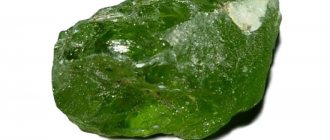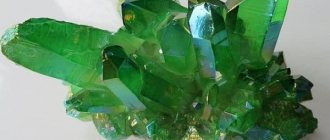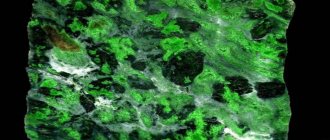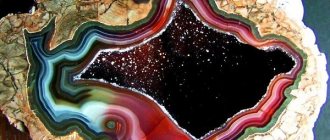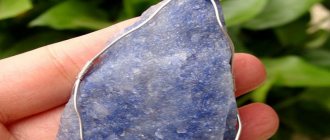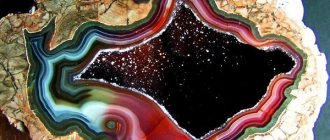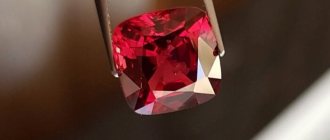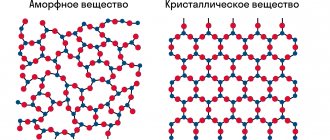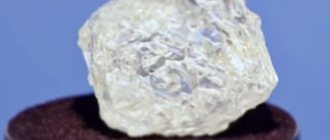Jewelry made from natural stones has always been highly valued. White coral is one of the natural minerals that has many benefits. It is graceful and fragile, brings good luck, and helps improve health. A woman looks especially elegant wearing a necklace. However, it is not always possible to find original products made from this stone. This article will tell you more about how to distinguish a natural mineral from a fake, as well as its origin and magical properties.
Origin of white corals
White corals are formed as a result of the union of calcareous skeletons of polyps in warm seas, in particular in the Sea of Japan. Branches form at a depth of up to 200 meters under water. The tops of the mineral are of particular value. Polyps in Greece were called “corallions” - this is where the name corals comes from. The fossilized polyps contain calcium and aragonite. The main characteristics of the mineral: hard, opaque, quite fragile.
Knowing the origin of the sea gem and its properties, it becomes clear how to care for it. Original products require special handling: they should not be heated or placed in hot water. Before washing your hands, it is better to remove jewelry to preserve its matte shine. The attractiveness of the stone is that it is beautiful both in its original form and after processing.
How corals are turned into jewelry
Mineral extraction occurs in the depths of the seas, when corals are torn from the rocks using special nets. Then they are sorted and cleaned, cut and given an attractive appearance. This can be achieved by polishing and eliminating minor defects.
To create an elegant decoration, the branches are cut with special circular saws. If a stone is ground so that its shape becomes ideal, up to 70% of the raw material will be lost. Such corals are quite expensive. Shade also matters. The greatest value in jewelry is white corals without grayish impurities.
Beads and bracelets are made from them. When combined with precious metals, often gold, coral jewelry is more expensive due to the weight of the metal and the work itself. In terms of external features, coral is similar to rhodonite and carnelian.
Application
White coral is, of course, most often used to make jewelry. The form of the mineral can be different:
- ball;
- cabochon;
- plate;
- cylinder.
But the most popular are products where coral has its own natural shape. Such bushes look very impressive and stylish.
In addition to jewelry, low-quality specimens of the mineral are used to obtain lime in construction. It is also used in medicine and cosmetology. It is used to produce body and hair care products.
The healing properties of white coral
The healing properties of white coral have been known since ancient times. It contains a lot of substances such as calcium, which is indispensable for humans. It is for this reason that coral is included in medications that require calcium.
In addition, it improves blood composition, normalizing glucose levels, and helps get rid of cardiovascular diseases. Coral is recommended to be taken in case of intestinal spasms, impaired protein metabolism and in case of diseases of the genitourinary system. To do this, it is dissolved in wine or water. This healing substance is indispensable for dental prosthetics, and can also reduce fever and stop bleeding.
If you have problems with the nervous system, suffer from insomnia or suffer from bronchial asthma, white coral will also come to the rescue. It will make you calmer and more balanced, relieve anxiety and even be able to stop asthma attacks.
It is believed that coral protects the human vocal apparatus. This is especially important for those who sing professionally or perform a lot in public. In such cases, it is recommended to carry coral products with you.
CORAL CALCIUM HISTORY
Late 1950's - Mr. Nobuo Someya starts researching the sango coral reefs around Okinawa, Japan. He develops a process to use the fossilized coral from sands which are from broken off coral caused by wave and tidal action. Mr. Someya's process benefits the human body by helping to correct the bodies alkaline/acid balance (body fluids like saliva should be 7.1 - 7.5 pH for optimal health).
1963 - Mr. Someya founds Coral Biotech Co., Ltd. of Okinawa, Japan to process one gram (tea type) bags of coral in foil packets. The original product is distributed by Ericsson's group in Sweden. Mr. Someya patents his process in the US, France, Germany, UK. The US patent numbers are 4,463,031 and 4,540,584. The patents are still Mr. Someya's property.
1986 - Mr. Someya sells Coral Biotech and his Vice President, Mr. Oda, becomes the new president with an agreement that Mr. Someya will receive royalties on all coral made and sold under his patents. Mr. Someya starts Marine Bio Co., Ltd., to manufacture coral filters for industrial applications and does not compete with Coral Biotech in producing foil packs while his royalties are paid to him.
1995 - Arthur Franklin, Founder of HTN enters into an exclusive agreement with Rolf Ericsson to distribute Ericsson's Alka-Mine Coral Calcium in North America.
1996 - Coral Biotech stops paying Mr. Someya royalties. Mr. Someya sues Coral Biotech to stop selling coral. Mr. Someya's lawyer, Mr. Haig Oghigian sends HTN a letter of “cease and desist” to stop selling Coral Calcium in the US Art Franklin goes to Japan in June '96 to meet with Mr. Oda of Coral Biotech and Mr. Someya of Marine Bio Co., Ltd. to find out the real truth about the coral situation. He learns that Mr. Someya is the original researcher, developer and patent holder of the coral process and HTN signs an agreement to purchase directly with worldwide rights for Alka-Line™ Coral Calcium product from Mr. Someya of Marine Bio Co., Ltd. The coral coming from Mr. Someya at Marine Bio Company is found to be superior in testing and all health benefits compared to Coral Biotech, because of Mr. Someya's developments in improved processing since the sale of Coral Biotech.
1997 — Art Franklin takes his third trip to Japan to participate as the only American and one of the five guest speakers in the celebration of the grand opening of their new 50,000 square foot coral processing plant in Nagano, Japan.
2001 — After five years in court Mr. Someya wins a cease and desist against Coral Biotech to stop production of coral products 2/28/01. March 2001, Art Franklin returns to Japan to visit Mr. Someya and his new Coral Production Facilities in Nagano.
(Machine translate)
The magic of coral jewelry
Initially, white corals gained popularity in European countries, where they were considered a sign of happiness and longevity. These minerals were a symbol of purity and purity of intentions. The magic of the stone is associated with a positive effect on the state of mind of its owner.
It is recommended to wear a white sea gem for those who often suffer from depression, fatigue, and decreased performance. Coral will help irritable and aggressive people find peace of mind and peace. He will protect you from temptations and save you in tense situations.
When a person goes on a trip, he can be sure that he will return safe and sound, since this stone will protect him from possible troubles. Fortune tellers use the white gem for magical actions where they need to predict the future. The products are suitable even for children - amulets are made for them.
Magic properties
It is also impossible not to mention the energetic properties of coral stone. In different countries, a variety of abilities were attributed to him. Thus, the ancient Greeks believed that the stone could prolong life and bring happiness. Many of them wore jewelry with the gem for decades without removing it.
Magical properties may vary slightly depending on color.
The Romans were inclined to believe that coral was the most reliable protection against evil spirits. Such properties are also recognized by modern psychics. According to their views, the stone makes the wearer invulnerable to damage, evil eyes, love spells, and curses.
The Hindus also believed in the protective power of the mineral from the depths of the sea. In this country, however, coral was considered not only a protective amulet, but also a stone of sages. It is believed that its aura enhances the magical abilities of the wearer.
Many researchers of the magic of stones are inclined to believe that coral protects the owner along the way. He helps you return home safe and sound. The stone can also protect a person from violence, both physical and emotional. At the same time, the energy of coral is very soft, so it is suitable even for small children. Thanks to the stone, babies will sleep better and get sick less.
Who is it suitable for?
Coral is suitable for romantic and sophisticated natures, as well as those who seek to develop these qualities. Women are recommended to wear white corals to a greater extent than men, as they affect the character of the owner. Tenderness and sophistication of manners will be useful to beautiful ladies, and masculinity will be strengthened if you have red corals with you.
Travelers can also use a white stone as a talisman.
Astrologers believe that all zodiac signs can wear the white mineral, but it is especially favorable for those born under the signs of Capricorn and Pisces. The first one will give romance and some sublimity, and Pisces will help Pisces become more self-confident.
Coral stone and zodiac signs
Compatibility with stones is a subject of debate and a rather vague concept. Astrologers assure: everything is ruled by the stars. So the constellation under which you were born indicates whether the talisman is suitable for you or not.
Coral stone can have different effects on representatives of different zodiac signs. Much also depends on the color.
- Pisces are compatible with a living gem better than all other signs. The mineral will help them become healthier and luckier. Red or brown specimens are most suitable for such people.
- The energy of Cancers also harmonizes well with coral, but it is better for them to prefer pink stones.
- Aries , Taurus , Sagittarius and Libra are able to achieve mutual understanding with the sea mineral. Its energy will help them not to be afraid of the effects of black magic. The crystal will also make such owners more attractive to the opposite sex and help them find friends.
- Scorpios and Leos can wear coral, but not too often. When used correctly, the stone will help them improve their health and prolong their life.
- Astrologers do not recommend using sea mineral for Virgos and Capricorns Their aura blocks the crystal's abilities.
It should be noted that astrological recommendations are not absolute. For example, the nature of the medium is of great importance. Coral does not like cruel, hypocritical, deceitful people. What is also important is how the stone came into your hands.
The ideal option is to find it yourself in the sea and process it yourself, but not everyone is capable of this.
A gem given to a loved one by a loving person will be a good amulet for everyone, regardless of their sign. Did you like the coral? We think you will also be interested in these stones: calcite, flint, aventurine. Enjoy reading!
How to distinguish fake coral from real one
They learned to fake corals a long time ago, when there was no trace of high technology. Previously, glass beads, porcelain, animal horns, various minerals (cacholong, howlite), and petrified bones acted as counterfeits. Nowadays, the number of counterfeits has increased due to various chemical compounds: plastics, polymer resins, etc.
Another way to counterfeit the originals is to grind mollusk shells into crumbs for further use in combination with lime spar. The calcinite contained in this fake is the only thing left of the marine exoskeleton of the coral.
There are several practical recommendations for identifying whether a copy is real or fake:
- Having cut a coral branch, you can notice its radiant structure, and not the crumbs that have been compressed. Jewelers use wax-based polish to so-called “stabilize” or protect the coral from destruction. By their nature they are very fragile. The coating on coral does not shine, like on a fake glass or porcelain, but has a calmer, matte tint.
- As an experiment, you can heat the coral, then it will stop shining, turn gray and crumble. When the imitations are heated, the smell of burnt plastic is felt and it turns black.
- Put a natural mineral in water - it will become brighter because it will absorb the liquid. This will not happen with a fake.
- If you compare the weight of coral and its imitation, the original product will be lighter and warmer to the touch. Painted fakes can be scraped off. Under the layer of paint, you will find a material of a different color that has nothing in common with natural stone.
- A real sea mineral does not dissolve in acid, but may not burn too intensely.
When buying a rare item, pay attention to the cost - it should not be low if you have real coral in front of you. It is recommended to seek the services of a professional who will help distinguish the original from the fake. In specialized stores with a good reputation, you are more likely to find a worthwhile original copy.
How to spot a fake
As polyp habitats have been threatened by pollution and intensive development, natural coral has become less common on the market than before. There are several technologies for growing artificial stones. They are much cheaper than natural ones. Some unscrupulous sellers sell such products at the price of genuine crystals.
The most similar to their natural counterparts are the so-called Gilson corals. They were invented in 1972, in laboratories in Switzerland. Such stones are grown from calcite powder. Their cost is much lower than that of natural minerals, but they look almost like real gems from the depths of the sea. However, there are still differences. If you examine such a crystal under a magnifying glass, you will not see a specific mesh pattern.
Another gem very similar to coral, but cheaper, is quartzite. To distinguish it from a king, it is enough to lightly press the purchase against the skin. Inorganic quartz will remain cold. The coral will warm up from the heat of the human body.
The cheapest imitations are created from pressed coral shavings. This is waste from mineral processing in jewelry workshops. Completely “budget” options that can’t even be called stones—just pieces of plastic or glass. Such fakes are easy to distinguish - they always have a uniform color. This happens very rarely with genuine crystals.
There are several universal authentication methods that were invented back in the Middle Ages. For example, you can carefully break off a small piece from a stone and throw it into vinegar. The natural crystal will react violently. If it stays in water for a long time, it will become brighter, but this will not happen with a fake. Finally, you can place the stone in a mug of milk. The natural mineral will color it pinkish.
Where are corals mined?
Most corals are found in the western Mediterranean, especially Sardinia. Known deposits are located in the Red Sea, Bay of Biscay, Malaysian Archipelago, Midway Islands, Japan, Taiwan, Australia and the Hawaiian Islands. The most famous coral reef is the Great Barrier Reef off northeast Australia, which extends over 1,250 miles.
Pink coral beads with gold clasp $1200
Coral products, prices
Decoration pink coral
A wide range of jewelry, crafts, souvenirs and decorative elements are made from corals. Coral beads, earrings, rings and brooches and bracelets - the mineral is processed, trying to preserve its natural shape as much as possible, and is framed mainly in silver.
The price of coral products depends on standard characteristics - the number of stones, their quality, color and place of extraction, as well as the material of the frame, if any. The cost of jewelry with corals ranges from:
- $45 – for silver earrings with inserts of red coral in the form of beads;
- $75 – for a set of jewelry with corals, which includes earrings, a bracelet and small beads;
- $90 - for a silver ring with an insert of a large coral of rich cherry color;
- $130 – for short earrings and beads made from blue corals.
Corals in history
The first mentions of corals go back to the origins of the Sumerian civilization, which inhabited the planet more than 5,000 years ago. And the oldest discovery of red corals dates back to the Mesopotamian civilization, that is, from about 3000 BC.
Coral jewelry has been found in ancient Egyptian and European burials. The ancient Egyptians used coral shards in their tombs as protection against evil spirits in the afterlife.
The indigenous people of South America, the Mayans, wore beads carved from coral. They were believed to protect the owner from evil spirits. And in eastern countries they made rosaries from corals, which was an integral part of religious rituals. They decorated book covers and encrusted weapons.
In the early 10th century, there was significant trade in coral between the Mediterranean and India. At that time, in India and Europe, corals were valued on a par with pearls. Only wealthy townspeople could afford jewelry made from this material.
Corals were especially popular during the Victorian era. In the 19th century, it was fashionable to combine modest coral with the most expensive stones - diamonds.
The Gauls often used coral as decoration for their helmets and weapons, considering it a protective stone. The Romans hung coral branches around their children's necks to protect them from danger. And Roman women wore coral earrings to attract love. At the beginning of the 20th century, residents of Italy used them to protect against the “evil eye” and against infertility.
According to the Arabs, coral bestows good fortune. Therefore, there is a custom to give small children a coral pendant to wish them a happy and peaceful life. In Egypt, it was laid out on the ground to protect crops.
Coral rosaries were very popular in the late Middle Ages for protection, especially for children. Therefore, in Italy you can find images of the Child Jesus with a coral necklace.
There are many legends about corals. One legend says that when Perseus cut off Medusa's head, they were on the seashore. Her blood flowed onto the seaweed and froze, causing it to take on the color of her blood.
